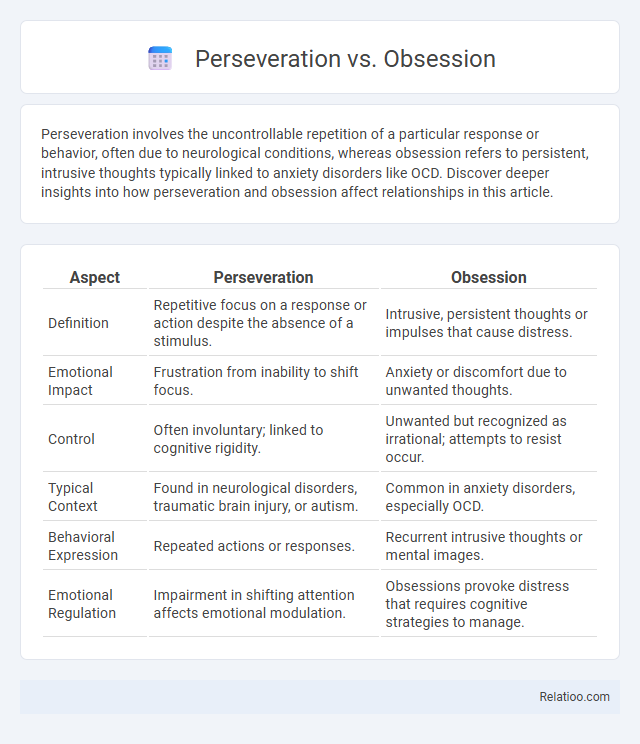Perseveration involves the uncontrollable repetition of a particular response or behavior, often due to neurological conditions, whereas obsession refers to persistent, intrusive thoughts typically linked to anxiety disorders like OCD. Discover deeper insights into how perseveration and obsession affect relationships in this article.
Table of Comparison
| Aspect | Perseveration | Obsession |
|---|---|---|
| Definition | Repetitive focus on a response or action despite the absence of a stimulus. | Intrusive, persistent thoughts or impulses that cause distress. |
| Emotional Impact | Frustration from inability to shift focus. | Anxiety or discomfort due to unwanted thoughts. |
| Control | Often involuntary; linked to cognitive rigidity. | Unwanted but recognized as irrational; attempts to resist occur. |
| Typical Context | Found in neurological disorders, traumatic brain injury, or autism. | Common in anxiety disorders, especially OCD. |
| Behavioral Expression | Repeated actions or responses. | Recurrent intrusive thoughts or mental images. |
| Emotional Regulation | Impairment in shifting attention affects emotional modulation. | Obsessions provoke distress that requires cognitive strategies to manage. |
Understanding Perseveration and Obsession
Perseveration refers to the repetitive and continuous behavior or speech, often due to brain injury or neurological conditions, where an individual struggles to switch from one thought or action to another. Obsession involves intrusive, persistent thoughts or urges typically linked to anxiety disorders, particularly obsessive-compulsive disorder (OCD), causing significant distress. Understanding the distinction between perseveration and obsession is crucial for accurate diagnosis and treatment, as perseveration stems from cognitive dysfunction while obsession is rooted in anxiety-driven patterns.
Defining Perseveration: Key Characteristics
Perseveration is characterized by the uncontrollable repetition of a particular response, such as a word, phrase, or gesture, even when it is no longer appropriate or relevant. Unlike obsession, which involves intrusive and persistent thoughts, perseveration is a behavioral pattern often linked to neurological conditions like autism or brain injury. Understanding these key characteristics helps you differentiate perseveration from obsession and compulsion, guiding more accurate diagnosis and treatment.
What is Obsession? Core Features
Obsession is characterized by persistent, intrusive thoughts, images, or urges that cause significant anxiety or distress and are typically recognized as irrational by the individual. Core features include repetitive, uncontrollable mental events that disrupt normal functioning and often lead to compulsive behaviors aimed at reducing anxiety. Unlike perseveration, which involves the unwanted repetition of a response or behavior, obsession primarily affects cognitive processes and emotional states.
Psychological Roots of Perseveration
Perseveration is a psychological phenomenon characterized by the repetitive continuation of a response or behavior beyond its appropriate context, often linked to damage in the frontal lobes affecting executive functioning. Unlike obsession, which involves intrusive and distressing thoughts rooted in anxiety disorders such as OCD, perseveration reflects an inability to shift cognitive or behavioral sets typically caused by neurodevelopmental disorders, traumatic brain injury, or neurodegenerative diseases. Understanding the neurobiological basis of perseveration, including disruptions in the prefrontal cortex and basal ganglia circuits, is crucial for distinguishing it from compulsive behaviors and for developing targeted therapeutic strategies.
The Science Behind Obsession
Obsession involves intrusive, persistent thoughts driven by neural circuits linked to the brain's reward and fear systems, particularly the orbitofrontal cortex and anterior cingulate cortex. Perseveration, in contrast, refers to the repeated, involuntary continuation of a behavior or response, often linked to frontal lobe dysfunction rather than compulsive worry. Understanding how your brain processes these distinct mechanisms can clarify why obsessive thoughts feel uncontrollable, highlighting the importance of targeted therapeutic interventions.
Perseveration vs Obsession: Key Differences
Perseveration involves the repetition of a response or behavior beyond its appropriateness, often due to neurological conditions, whereas obsession is characterized by intrusive, distressing thoughts typically linked to anxiety disorders such as OCD. Your ability to distinguish between these lies in recognizing perseveration as a behavioral repetition and obsession as persistent mental preoccupation. Understanding this difference is crucial for accurate diagnosis and effective treatment strategies.
Impact on Daily Life: Comparison
Perseveration, characterized by repeated or prolonged focus on a specific response or activity, can disrupt daily functioning by limiting cognitive flexibility and adaptability. Obsession involves intrusive and unwanted thoughts that often cause significant distress, leading to compulsive behaviors aimed at reducing anxiety and impacting daily routines. Compared to these, perseveration is primarily a cognitive rigidity issue, while obsession entails emotional distress, both affecting daily life but through different mechanisms and requiring distinct therapeutic approaches.
Common Causes and Triggers
Perseveration, obsession, and rumination share common causes rooted in psychological and neurological conditions such as anxiety disorders, obsessive-compulsive disorder (OCD), and traumatic brain injuries. Triggers often include stress, emotional distress, fatigue, and environmental stimuli that reinforce repetitive thought patterns. Understanding these overlapping factors aids in differentiating the persistence of thoughts and behaviors characteristic of each condition.
Diagnostic Criteria and Assessment
Perseveration involves the uncontrollable repetition of a response or behavior, often linked to neuropsychological conditions like brain injury and characterized by difficulty shifting cognitive sets, while obsession refers to intrusive, recurrent thoughts typically diagnosed under obsessive-compulsive disorder (OCD) criteria involving anxiety and distress. Diagnostic assessment of perseveration includes neuropsychological tests such as the Wisconsin Card Sorting Test (WCST), which measures cognitive flexibility, whereas obsession is evaluated using clinical interviews and standardized scales like the Yale-Brown Obsessive Compulsive Scale (Y-BOCS). Understanding these distinctions is crucial for your accurate diagnosis and tailored intervention strategies in clinical practice.
Strategies for Management and Intervention
Effective management of perseveration involves structured behavioral interventions such as cognitive-behavioral therapy (CBT) and mindfulness techniques designed to redirect repetitive thoughts or actions. Obsession is best addressed through exposure and response prevention (ERP) combined with pharmacotherapy, often using selective serotonin reuptake inhibitors (SSRIs) to reduce intrusive thinking patterns. Interventions for perseveration also emphasize environmental modifications and skill-building exercises to enhance cognitive flexibility and reduce fixation on certain stimuli or tasks.

Infographic: Perseveration vs Obsession
 relatioo.com
relatioo.com